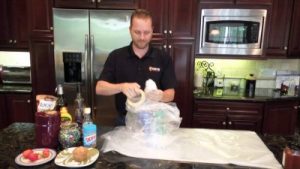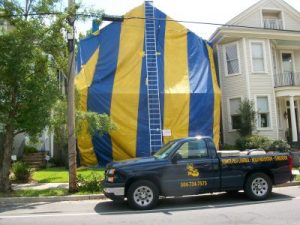
Termite infestation may lead to spending thousands of dollars.
This is all because of wood damage as termites choose cellulose as their food.
Tenting is one of the most effective ways against termites.
Hide content
- What will you need to prepare for tent fumigation of your house?
- How to prepare for termite tenting?
- Useful articles
- Helpful video
- Conclusion
Professionals use special gas in order to get rid of termites which prosper over the ground and eat walls, floors, ceilings, balks, etc. Pest exterminators seal the house under the tent and make it full of poisonous gas.
Fumigation is done with special chemicals which do not have smell and color. For the owner of the house it is important before, during and after termite treatment to follow the instructions in order to protect his family and pets.What will you need to prepare for tent fumigation of your house?
Before speaking about how to prepare your house for termite tenting, let’s speak about necessary equipment:
- Plastic bags or containers which can be sealed (to put all the food, medicine, tobacco if you are not planning to take them out).
- Plastic containers where you can place all food which has cardboard boxes.
- Plastic or any other special covers to protect your mattresses and some other furniture.
- A phone to call Gas Company.
- Garden shears.
- Garden hose.
- Garden rake.
- Keys to all locked household areas/items.
- A place to stay for two-three days (for the whole period of fumigation process).
Learn more about drywood termites: signs of their activity; best methods of treatment: spot treatment and DIY methods; how to get rid of them in furniture?
How to prepare for termite tenting?
Here is the termite tenting preparation checklist, that will help you to be sure that everything was done properly. Find the place where you, your family and pets can live while you have termite treatment in your house. Your house will be sealed for 2-3 days and you should be at a safe distance from your house.
You will not be allowed to enter the house until the tent is removed, the house is aired and the air is checked with special equipment (in order to make sure that it is safe and you can come back).Take all the food and tobacco away or put them in a special bag. Ask your pest control service whether they have special nylon or plastic bags for keeping products.
Food that you keep in the fridge must be taken away as well, or you can place it in the bag and leave in the fridge. You may also leave all jars, bottles, cans, etc. if they are originally hermetically closed.
For example, you do not have to bag or take out metal or glass liquor which is originally sealed. Inspect all the bottles and check to see they are sealed.
If containers had been opened or you are not sure that they are hermetically closed, you will need to put them in bags.
You should also carry all the medicine out.
Any kind of food which has dry package (cardboard boxes, for example), even if it wasn’t opened and has originally sealed box, has to be taken out or bagged.
This may include chips, flour, cereal, etc.
It is a good idea to use double-packaging.
So, you can put one bag in another and place all the needed objects inside. Double-packaging will make protection more effective.
Before fumigation (one-two days earlier) try not to buy any extra or unnecessary products. That will create additional work and you will have to look for a place to keep extra food or buy new packages.
Leave covers, furniture, boxes, cases, appliances, interior doors, etc. open or take them away if possible.
You will have to take out all valuable things such as money, jewelry, etc. This is all because you have to leave safes open as well. Even if you do not want to do it, you will have to give all keys to the exterminator to make him able to perform qualitative fumigation.It is not needed to put dishes or clothes in bags as fumigant will not harm or somehow damage these things. Basic air ventilation after fumigation process will be enough.
Drapes, jalousies and shutters should be open in order to make it easier for exterminators to air the house after fumigation.
If you use natural gas for heating or any other purposes and you have gas pipe line, you will have to cut it off temporary. Find out in advance where and how you can do it, and do not forget to plan your time.
Usually turning off the gas is to be done the day before fumigation and by someone from the gas company.
Turn off all the interior and exterior lights, water heaters, washers, dryers, ovens, computers and any other electric appliances.
Preparing for termite tenting from the outside of the house.
Take off all the antennas, wires and satellite antennas. Exterminators will fix the tent on the ground.
If your house is somehow touching the fence, most probably Pest Company will ask you to remove it.
As far as the company covers the whole house with a tent, the most effective fumigation will be provided if nothing blocks the right tent setup.
All the space within twelve to eighteen inches of your house will be covered by a tent. Plants and trees around the house should be removed for a place for the tent.In order to protect the roots of your shrubs water plants and trees around the perimeter of the house. Water should reach the depth of six inches as that will be enough to prevent fumigants’ leakage out of the tent.
Rake decorative rocks and wooden mound at least 12 inches back from the exterior of your house.
Provide exterminator with a key to your house so that he could accomplish fumigation of your house, enter after fumigation, and accomplish aeration process of your house after fumigation.
Take all living matters out of your house. People, pets and plants are not allowed to stay in the house. Remember that there is no safe way to keep fish tank in the house during fumigation: you should also bring it out.
Stay in touch with the exterminator in order to find out when it will be safe for you to come back to the house. Sometimes the date of tent fumigation may be delayed.
This may have different reasons (basically safety), but usually this might happen because of bad weather. In this case you should be ready to re-schedule your plans.
There is some special reminding for those who have babies or children. Of course, before starting fumigation all the food for children must be placed in special sealing bags or taken out of the housel.
You should also remember that you will have to remove all mattresses. The reason is their materials. Mattresses for children usually have details made of plastic or any other materials which do not leak (these details are mostly used for covering mattresses).
During fumigation process poisonous gases may penetrate mattress and it will be hard to air it out later.
It will be also a good idea to remove all other objects which may have plastic covering, or you may cover them with special bags as well.
Inform your neighbors about your fumigation plans and warn them to keep dogs and cats away from your house during the process.
Attention! Termite tents are used to treat drywood termites, not subterranean termites, which nest in the soil.Learn more about subterranean termites: signs of their activity; best methods of treatment and DIY methods. Eastern subterranean termites and their tunnels and tubes with photo.
You will not have to wash any dishes or clothes after fumigation.
The gas which is used for the process will dissipate very fast, especially after air ventilation.
But usually householders still rewash all possible things in the house to feel safe. As you can see preparing for termite fumigation is not very difficult process but for sure this procedure should be done properly and carefully.
Here you can learn more information about tenting: dangers for termites, cleaning after fumigation, how long does this procedure last?
Useful articles
If you interested in more information of termites we recommend you to read the following articles:
- All types of termites. Are they harmful to humans? Can they bite you? And what is the difference between drywood and subterranean ones?
- What does swarmers of different species look like: drywood, subterranean, formosan?
- Signs of infestation outside and in the house: in walls or furniture.
- What does termite holes look like? What is droppings and is it toxic to humans? Do termites make noises?
- Posible termite damage, how does it look like? Examples of damage in walls and wood floors.
- All about flying termites: how do they look like, swarming season and what to do if there are swarmers in your house?
- How do they do nests and mounds? How to find it in your garden or inside the house?
- Termite life cycle – from egg to larvae. And social hierarchy: workers, soldiers, queen.
Helpful video
This video covers the general process and procedures of fumigations:
Conclusion
Remember, that in order to protect yourself and your family do not enter the house until it is air ventilated.
The exterminators must ensure you that the house is safe.
In order to be fully informed about termite fumigation preparation process and after it do not be afraid to ask the exterminators any questions you have.
It will be also a good idea to call the Pest Company and ask them to come sometime before starting fumigation process. They will check whether you have done all the termite tenting preparations in a right way and may give extra recommendations.

